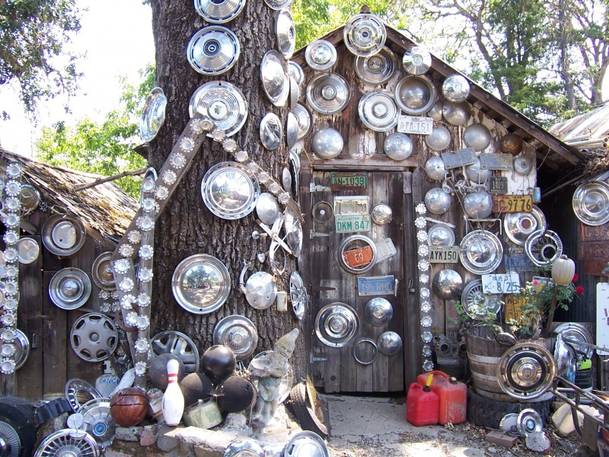It’s that time in the semester where I take my aesthetic theory class on a photographic tour of, among other spots, three California Italian American vernacular sites: Simon Rodia’s Watt’s Towers in Los Angeles, Baldassare Forestiere’s Underground Gardens in Fresno, and Litto Damonte’s Hubcap Ranch in Pope Valley.
My current interest lies chiefly with the last, since the Watts Towers and the Underground Gardens are the better known of the three. In addition to miscellaneous scholarly articles, academic presentations, dissertation chapters, and coffee table books, the Watts Towers has been the focus of a few documentaries (including the 2006, I Build the Tower) and will even be the subject of a conference in 2009 in Genoa. While not quite as hot as Rodia’s work, Forestiere’s Garden has likewise garnered academic and journalistic attention; moreover, the “mole man” is the protagonist of a T. Coraghessan Boyle short story, and no doubt his gardens will be mentioned in the upcoming one-day conference “Italian Farming in the Central Valley,” which will include a panel on the Italians of Fresno.
I share here what some of my students had to say today about these two spots.
On the Watts Towers

“What fascinates me is how he/his tower eventually created a bond with the community even though he was not socially all that present in the community, that the art piece (a pure expression of Rodia, the person) connects him to a greater community.”
“Out of all we studied this feels the most like art to me, the kind of thing where I could walk through with my head tilted up and holding my breath.”
On the Underground Gardens

“The strength of his vision is obvious not to mention his will power and physical body strength.”
“Hands down the most impressive….he took in all measures of nature and adapted them to his lifestyle.”
“It shows that with some determination we can change the way we are supposedly destined to live.”
“Tunneling as a replacement for social interaction.”
HUPCAP RANCH
In comparison to the Watts Towers or the Underground Gardens, the Hubcap Ranch in Pope Valley is much more modest, simple even. And yet it merits our attention just the same.
The town of
Pope Valley [2] sits off the Silverado Trail, between Napa and Calistoga. To get there one has to drive through “wine country”—a term that over the last thirty years has come to mean upscale restaurants, boutique wineries, and exclusive art galleries, many of which have a heavy Italian flavor. Pope Valley remains, for now at least, outside of this California foodie cultural scene.
The Watts Towers sit in a residential neighborhood, among California mid-century bungalows; the Underground Gardens are right off a freeway, and the last time I was there a Harley Davidson dealer was across the street. But across the street from the Hubcap Ranch is nothing, just an empty field.
Emmanuele “ Litto” Damonte was born in 1892, emigrated from Italy (Arenzano, province of Genoa) as a young man, and quickly ended up in California. He bought land in Pope Valley while he worked in masonry in South San Francisco and would bring his family up to the Valley for the summers, eventually re-locating there permanently. Word is that starting about 1932, he began tacking up the hubcaps lost when people drove the curved, unpaved road up from his house. Folks rarely ever came by to look for them; instead, others started leaving hubcaps. Pretty soon, Damonte was artistically arranging his hubcaps all over his land: along the fence that lines the driveway, on the trees outside of his house, along the outdoor, roofed patio, on the walls of the house, barn, and sheds along his property.
But in the spirit of other outsider/self-taught/folk/vernacular artists (I’ll leave the academic debate about what’s the best term for some other time), Damonte began incorporating found everyday objects into his creation as well. Today his grandson Mike lives on the property with his family—they have continued to add to the hubcap-aspect of the site, but less so to the rest of the creation.


The photos above and below, all snapped last summer, show some of the details that have remained since Damonte died in 1985. Notice the remains of shrines, some more obviously religious in nature than others. The garden tools woven into the fence. The tractor cemented in place. Notice also what he did with the bottom of soda/beer cans, cutting them to create a repeated, floral design and using the old pull-tabs both to create garland and decorative balls.
Like other vernacular artists, Damonte was an eco-artist before it was hip, applying his artisanal skills in construction and masonry to (re) use found everyday objects and religious icons to create art of his daily space. The space he built, like that of Rodia's and Forestiere's, has a particular Italian (male) immigrant feel to it precisely because of the way material culture comes to define his labor.
Idiosyncratic. Driven. Sacred. Creative. Inspired.










